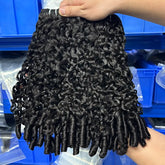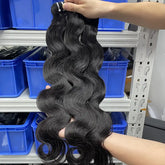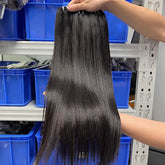Burmese Hair Is Rare. Why You Should Be Cautious When Everyone Claims to Have It

In today’s global wig and extension market, the term “Burmese hair” is everywhere. Many suppliers advertise it, but very few actually source the real deal. For salons, boutiques, and professional buyers, knowing how rare Burmese hair truly is—and how to verify it—can save money, reputation, and customer trust.
Why Is Burmese Hair Considered Rare?
Burmese hair comes from Myanmar (formerly Burma), a country with a much smaller population than India or China. This means the donor pool is limited, making authentic Burmese hair naturally scarce. In addition:
- Population size: Myanmar’s population (~55M) is smaller compared to India (~1.4B).
- Donor traditions: Fewer cultural practices of hair sacrifice compared to India.
- Political instability: Ongoing challenges in Myanmar make consistent sourcing difficult.
What Makes Authentic Burmese Hair Unique?
Burmese hair has distinct qualities that stylists and clients love:
- Texture: Naturally thick, slightly coarse, yet soft—ideal for blending with Afro-textured hair.
- Versatility: Can hold curls or straighten without losing structure.
- Durability: With proper care, lasts longer than many mass-market alternatives.
Does Every Supplier Really Have Burmese Hair?
Simply put: No. Because authentic Burmese hair is so rare, many suppliers re-label cheaper alternatives (such as Indian or mixed Southeast Asian hair) as “Burmese.” This is a common industry problem.
Red flags to watch for:
- Suspiciously low prices (real Burmese hair is never cheap).
- Large inventory availability year-round (a true rarity wouldn’t be endless).
- Lack of transparency about sourcing.
How Can You Verify Burmese Hair Authenticity?
Professional buyers can use a few practical methods to confirm authenticity:
- Ask for sourcing details: Genuine suppliers can explain their chain of custody.
- Check the texture: Burmese hair has a distinct, thicker strand diameter.
- Perform a burn test: Real human hair burns slowly with a protein smell, while synthetic blends melt.
- Look at supply consistency: If a vendor always has unlimited stock, it’s likely not real Burmese hair.
Which Alternatives Should You Consider?
If you can’t find reliable Burmese hair, consider other raw hair origins with consistent quality:
- Cambodian Hair: Coarse, voluminous, and similar in strength.
- Vietnamese Hair: Naturally silky with durability, great for styling versatility.
- Raw Indian Hair: Readily available with high authenticity from temple sources.
What Does This Mean for Salons and Resellers?
For Black-owned salons, wig boutiques, and resellers, reputation is everything. Offering fake “Burmese hair” can damage trust with your clients. Instead, educate your buyers about rarity and focus on sourcing from transparent, reliable suppliers.
Pro Tip: Position authenticity as part of your brand story—it helps you stand out in a crowded market.
Conclusion: Be Smart, Not Fooled
Burmese hair is rare, unique, and valuable—but that also makes it one of the most misrepresented products in the hair industry. By learning how to spot authenticity, knowing what alternatives to consider, and prioritizing supplier transparency, you’ll protect your business and earn long-term customer loyalty.







